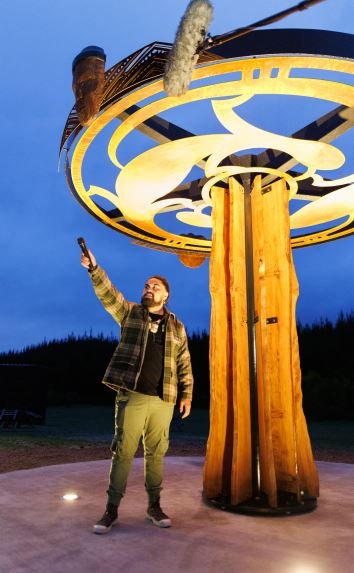Unveiling of Tūhourangi artworks at Te Pūtake o Tawa
PĀNUI PĀPĀHO - Rotorua Lakes Council | Te hura i nga pou whenua o Tūhourangi - Unveiling of Tūhourangi artworks at Te Pūtake o Tawa
On the morning of Saturday, 30 October five tāonga (artworks) were unveiled at Te Pūtake o Tawa in Rotorua in accordance with Tūhourangi protocol, tā i te kawa. Officiating tohunga, Mataia Keepa of Tūhourangi Ngāti Wāhiao conducted the proceedings.
Watu Mihinui, of Tūhourangi Tribal Authority, says “Tūhourangi acknowledges CNI Iwi Holdings Limited and Rotorua Lakes Council for allowing us to participate in this segment of the Whakarewarewa Forest Development project, and the powers at the time for the prudent investment that has enabled Nga Pou Whenua o Tūhourangi to be created at Te Pūtake o Tawa.”
The installation of the taonga, which is part of the Whakarewarewa Forest Development project, provides the ability to share kōrero (stories) of tūpuna (ancestors) that are important to Tūhourangi. Te Pūtake o Tawa has now become a place where the public and Tūhourangi descendants can learn about this whakapapa.
The local artists, who have been designing and creating these pieces over the past year, were selected by Tūhourangi and include a mix of both established and up-and-coming artists.
Watu Mihinui says Tūhourangi appreciates the opportunity to share their kōrero of events and ancestors that are central to present and future generations.
“We are sharing our whakapapa through Nga Pou Whenua o Tūhourangi, the Land Markers of Tūhourangi.
“It is a fantastic opportunity to exhibit five examples of Tūhourangi brilliance, flair, technique, skill and courage required to attempt the different media in these creations.
“The five artists are direct descendants of the principal ancestor portrayed at Te Pūtake o Tawa, the Tūhourangi chief - Umukaria, father of Wāhiao and Hinemoa, who are also portrayed here. The other taonga are of Kataore, the pet taniwha that roamed these hills and te kēti, a laser-cut tāniko design.”
Rotorua Mayor Steve Chadwick acknowledges the partnerships that have allowed this project to go ahead and applauds the artists for their exceptional work.
“Again this is an exceptional demonstration of partnership, between Council, mana whenua, CNI Iwi Holdings Limited and central government’s regional economic development and investment unit, Kānoa – REDIU, along with the support of Timberlands, that has enabled this aspect of the Whakarewarewa Forest Development to go ahead.
“Establishing a cultural foundation at Te Pūtake o Tawa, and throughout the forest, has always been a key component of this development and the unveiling of the taonga today really brings to life this very special place.
“Not only do we have a new forest hub and an additional access point to the forest, but we now have this significant story telling element which will be of huge interest to both locals and manuhiri.
“The artworks are spectacular and I commend and thank the artists for their phenomenal efforts to create these unique pieces that help tell the history and stories of the surrounding forest and wider district. We are so lucky to have this local talent and very privileged to be able to showcase it in our recreational spaces.
“I encourage everyone to visit Te Pūtake o Tawa to see these pieces for yourself, and learn about this special place and those that were here before us,” says Mayor Chadwick.
Te Pūtake o Tawa Tāonga
KĒTI TĀNIKO
Artist: Denise Morgan-Koia – Tūhourangi, Ngāti Rangiwewehi, Tainui
This taonga created by Denise Morgan-Koia, using sheet steel, is inspired by the Tūhourangi Ngāti Wāhiao (tribe of Whakarewarewa) Kapa Haka tāniko pattern.
The laser-cut design in the gate is inspired by the tāniko pattern used in the costumes of the Tūhourangi Ngāti Wāhiao kapa haka (Māori performing arts group), was designed in the early 1980's.
The gateway represents the rich cultural history of the Tūhourangi people who are mana whenua for this land and, when open, symbolises welcoming arms to all manuhiri (people from other lands) visiting Te Pūtake o Tawa.
The gate has a simple matt black colour to allow the beauty of the natural surroundings to come through the cut-out pieces of the design. The triangular and diamond shapes represent niho taniwha (shark teeth). The angular lines represent Aramoana (pathway of the sea), and signify the migration of the Te Arawa vessel, which carried early settlers to Aotearoa.
UMUKARIA (Chief)
Artist: Tukiri Tini - Tūhourangi Ngāti Wāhiao, Ngāti Whakaue, Ngāti Hinekura, Tainui, Ngāi Tahu
This tāonga depicts Umukaria, a great chief of the Tūhourangi tribe, who lived on the eastern shores of Lake Rotorua at Hinemoa Point six hundred years ago.
Artist, Tukiri Tini, has chosen the traditional form of toi whakairo (art of wood carving) to carve the four metre-tall tōtara.
One day Umukaria was invited to a meeting of chiefs at Motutawa on Rotokākahi (Green Lake). He thought the purpose was to put aside differences and try to establish peace among the tribes.
Umukaria and a small group made their way to Motutawa, but were surprised in an ambush and killed. Their bodies were laid together in a pile and that place became known as Te Pūkainga – the place where the dead were piled up. Umukaria’s head was later found in a cave at Lake Tarawera.
It was later discovered that the killing of Umukaria and his group was in response to his son-in-law, Tūtānekai, taking the lives of two brothers from that area.
Wāhiao, son of Umukaria, avenged the death of his father by leading the Tūhourangi people to victory in battle, including conquering Motutawa. To this day the island remains part of the Tūhourangi tribal estate.
WĀHIAO (Son of Umukaria)
Artist: Iwi Le Comte - Ngāti Wāhiao, Ngāti Rangiteaorere, Ngāti Tarāwhai, Rongomaiwahine, Ngāti Kahungunu ki Wairoa, Ngāi Tuhoe
This tāonga is a modern interpretation of the Tūhourangi warlord, Wāhiao, son of tribal chief Umukaria and younger brother of Hinemoa.
Iwi Le Comte created this sculpture utilising a ten tonne lava rock deposited in the forest during the 1886 Tarawera eruption and affixing a bronze mask recognising Wāhiao’s leadership, mana and strength.
Whilst his father lived at Hinemoa Point, Wāhiao lived on Pukeroa Hill in central Rotorua where the Rotorua Public Hospital now stands. When news of his father’s assassination reached him, Wāhiao was devastated but his people demanded he lead them to avenge the slaying of their chief, Umukaria.
A massive Tūhourangi war party assembled on Pukeroa Hill then marched to Whakarewarewa Village (2kms south of Rotorua township) to undertake training and then on to Rotokākahi (Green Lake).
Tūhourangi were victorious in battle at both major fortified settlements of Rotokākahi and Tarawera. They eventually settled the lakes of Rotokākahi, Tarawera, Rotomahana, and Ōkāreka. These areas remain part of the Tūhourangi tribal estate today.
KATAORE (Taniwha)
Artist: Tāwhanga Rika – Tūhourangi Ngāti Wāhiao, Ngāti Tarāwhai, Ngāti Rangiwewehi
This tāonga represents Kataore, an ancient massive lizard known by Māori as a taniwha. He lived in a cave on nearby Mount Moerangi and roamed freely upon these lands. Artist, Tāwhanga Rika, has created this sculpture using corten steel and mātai. The disc has a four-metre diameter and sits three metres high.
Tangaroamihi, who was the first settler in this area, made friends with Kataore who played with the children of his tribe. Soon Kataore became the tribal pet. As Kataore aged and grew to an enormous size, he spent more time alone and stories began to spread of travellers disappearing in the Moerangi area.
Eventually Kataore became uncontrollable and devoured a young woman who was making her way to Rotorua. Her fiancé was so upset that he raised a war party within his tribe that lived at Pukeroa Hill (in central Rotorua where the Rotorua Public Hospital now stands) to seek revenge and killed Kataore. Tangaroamihi mourned his pet but believed that he was the real target and that Kataore’s death was to trick him into battle.
Several fights followed, during which Tangaroamihi became a victim. However, the travelling war party was eventually defeated to such an extent that they left the Rotorua area.
HINEMOA AND TŪTĀNEKAI (Historical Romance)
Artist: Okiwi Logan Shipgood – Tūhourangi Ngāti Wāhiao, Ngāti Uenukukōpako, Ngāti Whakaue, Ngāti Tūmatawera, Ngāti Kahu Upoko, Ngāti Tarāwhai, Ngāti Hinekura
The children of Hinemoa and Tūtānekai are the main ancestors of the Ngāti Whakaue nation, prominent within the Confederation of Te Arawa Tribes. The historical romance of Hinemoa and Tūtānekai has been immortalised in this 3.5-metre-high cement taonga (artwork) sculpted by Okiwi Shipgood.
Hinemoa, daughter of Umukaria and older sister of Wāhiao, grew up at Hinemoa Point on the eastern shores of Lake Rotorua. She was a famous puhi (woman of high rank) destined for a marriage that would bring political benefits to her tribe. She was also a woman of strong opinions who had already selected her true love, Tūtānekai, and eloped by swimming 3.4 kilometres across Lake Rotorua to join him on Mokoia Island.
The favoured son of chief Whakaue, Tūtānekai lived on Mokoia Island with his father’s tribe. He was a ferocious warrior and quick to take offence. His killing of two brothers accidentally led to the ambush and slaying of his father-in-law, Umukaria at Motutawa on Rotokākahi (the Green Lake).
When Tūtānekai died after a long illness, Hinemoa expressed her deep grief and loss in the waiata aroha (ancient sad song of love) that is still sung by their descendants today. In her sorrow she hinted at no longer having the will to live and sought out her father’s people, Tūhourangi, at Rotokākahi where she lived out the rest of her days.
The final resting place for Tūtānekai is at Weriweri, a tiny settlement on the north western shores of Lake Rotorua at Ngongotahā.
This taonga is sited on the boundary of Tūhourangi and Ngāti Whakaue tribal estates on Mount Moerangi.
This taonga is sited on the boundary of Tūhourangi and Ngāti Whakaue tribal estates on Mount Moerangi.
Image (pictured above): Stephen Parker
Te Pūtake o Tawa background information
Te Pūtake o Tawa (also known as Tawa Forest Hub at 516 Tarawera Road) was developed as part of the Whakarewarewa Forest Development to provide additional recreational access to the forest, as well as opportunity for new commercial developments. The hub opened in October 2020.
To date Mountain Bike Rotorua and Tūhourangi Tribal Authority have both been granted concessions to operate within Te Pūtake o Tawa.
Mountain Bike Rotorua holds a concession for providing bike hire, retail and a forest shuttle service.
Tūhourangi Tribal Authority have partnered with a combination of other local businesses (Whakarewarewa Village, Mitai, and Grounded Café) to provide a food and beverage offering, and retail space.
The Whakarewarewa Forest Development has received a $7.09million Government investment managed by Kānoa - REDIU, which has been used alongside $7.5million from Rotorua Lakes Council, to enhance the forest amenity and improve the experience for all. This is a collaborative project between CNI Iwi Holdings Limited and Rotorua Lakes Council, with the support and guidance of mana whenua. Timberlands has also supported the development of Te Pūtake o Tawa.
For more information on the Whakarewarewa Forest Development project visit visiontoaction.nz.





